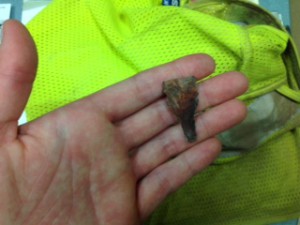I am currently sitting in the Days Inn Hotel in State College (my current Monday-Friday home) for three weeks. I am one of three graduate students that were hired as an intern for the PennDOT Highway Archaeological Survey Team (PHAST). We are getting a healthy dose of what it is like to work in CRM. Last week, this week and the follow week, we are digging test units upslope from the Juniata College field school at the Hatch Site. Prior to this project we have been working in Allegheny County and Indiana County. It has been a busy beginning of the summer, but I’ve learned so much so far! Another perk to this internship is getting to see the different parts of PA that I’ve never visited. Lucky for us, we are surrounded by great food (and beer) in State College. Tonight we are trying Austrian food!

The PHAST crew at the Hatch site: from left to right: Zaakiyah, Sami, and Gen.
Sitting here in my hotel room, I am reflecting on my first year of graduate school. Coming into the program I was pretty anxious about diving back into school after being out of academia for almost eight years. I took a long time off, working in the service industry, going to field school and working in CRM briefly. I wasn’t sure if I knew how to write a paper still. The first few weeks were a little rocky, but I kept pushing myself, and I got into a routine, and yes, I can still write. Time management is everything in graduate school, especially the first semester of your first year. It is impossible to leave any assignment until the last minute, because it is very likely that you have one or two assignments for another class due the same day or week. DO NOT PROCRASTINATE! You can ask anyone from the cohort above you, your quality of life will be much better if you just realize that you may be doing school work most days in order to get assignments done on time and at a level that is worthy of graduate school.
The place that I spent most of my time during the first year was in the graduate lounge and in my office that was provided to me for my Public Archaeology graduate assistantship (GA). The office and graduate lounge was especially helpful, because it was a place that I could work in peace. I live in Pittsburgh, so having a place to leave my lap top and other belongings was especially nice. My GA pushed me to get to know my cohort and the cohort above me a little better. Managing the blog and other social media outlets allowed me to take a break from academic writing, and do a little creative writing. Similarly, I was able to speak about issues, such as the defunding of the National Endowment for the Arts and the National Endowment of the Humanities freely. Ultimately, my GA made me feel like a part of the program that I may not have otherwise felt.
Getting to know your cohort is one of the best things you can do for yourself, and the professors drive this home to you from the very beginning. No, it is not possible to be friends with everyone, but making a concerted effort to get to know one another is helpful for two reasons: 1. You’re all going through the same stress, so they are likely the people that will understand what you’re going through the most 2. You are there to help one another when you’re confused about an assignment. These people are likely to become your co-workers in the future, but even better, your friends. Your reputation is everything in this field, so it is crucial to be professional, but also be willing to hang out and enjoy the moments that you’re not doing school work with them!
Finally, I found that taking part in every opportunity presented to me through the program is really important. Any colloquium or field trip that is offered, take advantage of it. This includes conferences (if you present a paper or poster you are eligible for funding). Your professors like to see you getting involved, but also, these are opportunities you may not otherwise get outside of school. We met a lot of important people, such as the advisory council for our program, and they looked at our resumes, and told us what CRM firms are looking for. We also had an opportunity to meet and hear Dr. Todd Surovell speak. You’re paying for your education, so make sure you take advantage of everything that times allows!

![IMG_1784[1]](https://iblog.iup.edu/trowelsandtribulations/files/2014/09/IMG_17841-1x6g8yc-300x200.jpg)


